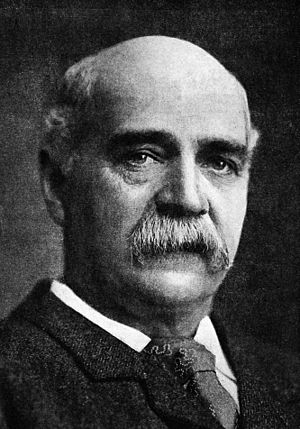William de Wiveleslie Abney facts for kids
Quick facts for kids
Sir William de Wiveleslie Abney
|
|
|---|---|

William de Wiveleslie Abney
|
|
| Born | 24 July 1843 |
| Died | 3 December 1920 (aged 77) Folkestone, England
|
| Known for | Photography |
| Awards | Rumford Medal (1882) |
| Scientific career | |
| Fields | Astronomy Chemistry Photography |
Sir William de Wiveleslie Abney (born July 24, 1843 – died December 3, 1920) was an English scientist. He was an astronomer (someone who studies stars), a chemist (someone who studies chemicals), and a photographer. He made many important discoveries that helped photography and science grow.
Contents
Life and Work of Sir William Abney
Sir William Abney was born in Derby, England. His father was Rev. Edward Henry Abney, a vicar, and his mother was Catharine Strutt. William went to Rossall School and the Royal Military Academy, Woolwich. After finishing school, he joined the Royal Engineers in 1861. He worked in India for several years. Later, he became a chemical assistant at the Royal School of Military Engineering. This helped him learn even more about photography.
How Abney Changed Photography
William Abney was a true pioneer in photography. His father was also interested in photography and was friends with Richard Keene, an early photographer from Derby. William and his brother Charles became good friends with Keene too. In 1884, both Abney brothers helped start the Derby Photographic Society.
Abney's work in the chemistry of photography led to new and better ways to take pictures. He also used his photography skills to help with astronomy. He wrote many books about photography that were very important at the time.
Making Photography Easier
In 1874, Abney created a new type of photographic emulsion. This was a "dry" emulsion, which was much easier to use than the older "wet" ones. He even used this new emulsion on a trip to Egypt. There, he took pictures of Venus as it passed in front of the sun. In 1880, he introduced a chemical called hydroquinone, which was very useful in developing photos.
Abney also invented new kinds of photographic paper. In 1882, he shared a recipe for gelatin silver chloride paper. These inventions made photography more accessible and better quality for everyone.
Abney's Work with Light and Stars
Sir William Abney also studied spectroscopy. This is a way to study light and see what it's made of. He developed a special emulsion that could "see" red light. This was used to study the infrared spectra of different chemicals.
In 1887, he was one of the first people to photograph the infrared solar spectrum. This means he took pictures of the sun's light that we can't normally see. He also researched how sunlight travels through the air.
Later Life and Inventions
In 1893, Sir William inherited Meashan Hall from a wealthy aunt. He continued his public service, becoming an assistant secretary and advisor to the Board of Education.
Abney also invented a tool called the "Abney level." This tool combines a clinometer and a spirit level. Surveyors use it to measure slopes and angles of land. He also created the "Abney mounting" for a special camera that studies light.
Sir William Abney passed away on December 3, 1920, in Folkestone, England. He is buried in the churchyard of Holy Trinity Church there.
Family Life
Sir William Abney was married twice. His first wife was Agnes Matilda Smith, whom he married in 1864. They had one son and two daughters. After Agnes passed away in 1888, he married Mary Louisa Mead in 1890. They had another daughter together.
Awards and Recognition
Sir William Abney received many honors for his important work:
- 1876: He became a Fellow of the Royal Society, a very respected group of scientists.
- 1878: He received the first-ever Progress Medal from the Photographic Society of Great Britain.
- 1885: He became a Fellow of the Royal Society of Edinburgh.
- He was President of the Royal Photographic Society several times (1892-1894, 1896, 1903-1905).
- He was President of the Royal Astronomical Society (1893-1895).
- He was President of the Physical Society of London (1895-1897).
- He was honored as a Knight Commander of the Order of the Bath (KCB) in 1900. This is a special award from the British monarch.
- He received an honorary Doctor of Science degree from the University of Dublin in 1902.
See also
- Abney effect

